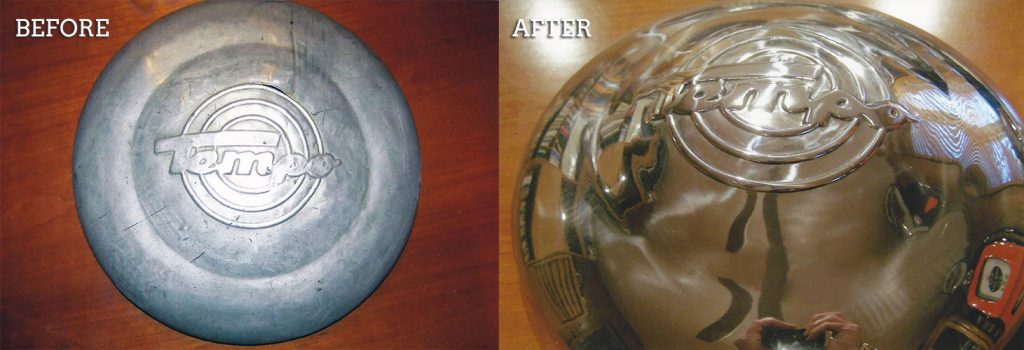Aluminum… Anodize or not?
Aluminum trim can be the most difficult type of automobile trim to restore. Nearly all automotive aluminum trim is anodized. For the most part this is clear, but some Chrysler and Ford products can also have gold anodizing. Anodizing prevents aluminum from oxidizing. It is an electro-chemical process. In simplest terms, the piece is put into a solution of water and diluted battery acid while an electrical current is passed through the aluminum. The anodizing actually “grows” out of the aluminum as an oxide. It is not an applied finish like chrome plating.
Anodizing creates a very hard and non-flexible finish, and causes some serious problems. Anything that cracks or penetrates the finish will allow water, road salt and other chemicals to attack the underlying aluminum. As is the case with pot metal, the result is corrosion and pits. Aluminum is also sensitive to temperature changes. Most cars are exposed to seasonal fluctuations, and aluminum does expand with hot summer days and contract with cold winter nights. Owing to the inflexible nature of anodizing, expansion and contraction of the aluminum causes small cracks and fissures to occur on the surface. Rear panel aluminum trim, near heated exhaust gasses, usually suffer the most damage. The level of deterioration is not fully detectable until the anodizing is removed by sanding or by stripping it off with caustic soda.
 Look closely at aluminum grills, headlight trim, rear finish panels and trim you will see what looks like tiny specs in the anodizing. These specs are all pits underneath the surface and there can be thousands to deal with in order to restore the piece. If moisture and exhaust fumes reach the back side of the trim, corrosion will also be present. This is a limited amount t of sanding and polishing that can be done on aluminum trim without going right through the metal.
Look closely at aluminum grills, headlight trim, rear finish panels and trim you will see what looks like tiny specs in the anodizing. These specs are all pits underneath the surface and there can be thousands to deal with in order to restore the piece. If moisture and exhaust fumes reach the back side of the trim, corrosion will also be present. This is a limited amount t of sanding and polishing that can be done on aluminum trim without going right through the metal.
Once aluminum trim is restored, there are choices regarding its finish. One can anodize the trim to original factory finish, leave it as-is and from time to time polish the trim to remove oxidation, or clear coat the trim with an epoxy or urethane finish.
If you are doing a 100-point car that will be judged you will want to re-anodize. This is an expensive process that not many companies offer. I can clear anodize or color anodize aluminum but it does add a substantial amount to the restoration cost. In addition to cost, a hazard of re-anodizing a restored piece of trim is that if you have to make any adjustments to make the trim fit properly or line up with accent pieces, you will crack your brand new anodizing. When light hits the piece from certain angles, it will cause a rainbow effect in that area.
If your car is not being restored to the highest levels of scrutiny, I advocate either leaving the restored aluminum alone and polishing as needed, or applying a clear coat to the surface. As with chrome plating, there are many companies that do industrial anodizing, but they will not deal with individual car parts as rare and valuable items. I regularly send trim to different firms to test the results. Typically, scratched and bent trim is returned.

